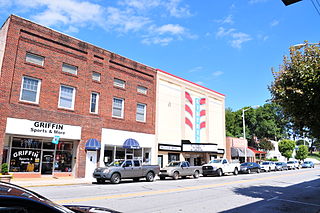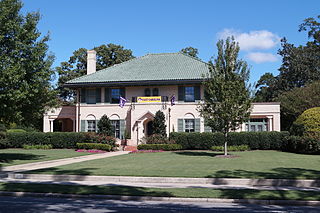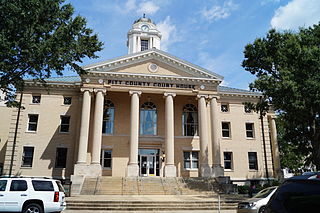
The Downtown Main Street Historic District is a national historic district located at North Wilkesboro, Wilkes County, North Carolina. It encompasses 29 contributing buildings in the central business district of North Wilkesboro. It developed between about 1891 and 1952, and includes notable examples of Classical Revival and Early Commercial style architecture. The architectural firm Benton & Benton designed the former Bank of North Wilkesboro II (1923), the Hotel Wilkes (1926), and the former Town Hall (1939). Other notable buildings include the Liberty Theater, former Bank of North Wilkesboro (1892), and Tomlinson Department Store (1927).
Benton & Benton was an architectural partnership in eastern North Carolina of brothers Charles C. Benton Sr. and Frank W. Benton. Several of its works are listed on the U.S. National Register of Historic Places. Charles C. Benton Jr. and others also worked for the firm.

The Ayden Historic District is a national historic district located at Ayden, Pitt County, North Carolina. The 146-acre (59 ha) district encompasses 319 contributing buildings and six contributing structures in the town of Ayden. It includes buildings dated from the late-19th to mid-20th century and notable examples of Bungalow / American Craftsman, Colonial Revival, and Queen Anne architecture. Notable buildings include the original Ayden Town Hall (1915), Turnage Brothers Building, Moore House, John Stanley Hart House, Thelbert Worthington House (1930) designed by Leila Ross Wilburn, Ayden Baptist Church (1941), the Lloyd and Lillian Turnage House (1923) and Ayden Methodist Church (1926) designed by Benton & Benton Associates, Zion Chapel Free Will Baptist Church (1924), and Mount Olive Baptist Church.

The College View Historic District is a national historic district located north of East Carolina University at Greenville, Pitt County, North Carolina. The district encompasses 343 contributing buildings in a predominantly residential section of Greenville. It includes buildings dated from about 1909 to World War II and notable examples of Bungalow / American Craftsman, Colonial Revival, and Tudor Revival architecture. Notable buildings include St. Paul's Episcopal Church (1930), the Rotary Club Building (1921), Chancellor's Residence, William Harrington House, Bateman House (1910), Franklin Vines Johnston House (1923), and Dr. Paul Fitzgerald House (1929).

West End Commercial Historic District is a national historic district located at Greenville, South Carolina. It encompasses 15 contributing buildings in Greenville's second "downtown." The commercial buildings primarily date from about 1880 to 1920, and include examples of Victorian commercial architecture. Notable buildings include the American Bank, Alliance and Mills & McBayer Cotton Warehouses, Indian River Fruit Store, Pete's Place, Bacot's West End Drug Store/Stringer's Drug, Furman Lunch, and Greer Thompson Building.
Downtown Asheville Historic District is a national historic district located at Asheville, Buncombe County, North Carolina. The district encompasses about 279 contributing buildings and one contributing object in the central business district of Asheville. It includes commercial, institutional, and residential buildings in a variety of popular architectural styles including Colonial Revival, Queen Anne, and Art Deco.

Downtown Greensboro Historic District is a national historic district located at Greensboro, Guilford County, North Carolina. When first listed, the district encompassed 96 contributing buildings in the central business district of Greensboro. The commercial buildings were built between about 1885 and the 1930s in a variety of popular architectural styles including Italianate and Art Deco. Located in the district is the separately listed Jefferson Standard Building. Other notable buildings include the Vanstory Building, Kress Building (1929), Woolworth's, Efrid's Department Store, Montgomery Ward (1936), the Carolina Theatre (1927), Center Theatre (1948), the former Belk Building (1939), Ellis Stone/Thalhimer's Department Store (1949-1950), and the former American Exchange National Bank Building (1920). The Woolworth's store is notable as the site of the Greensboro sit-ins of 1960.

Main Street Historic District is a national historic district located at Hendersonville, Henderson County, North Carolina. The district encompasses 65 contributing buildings in the central business district of Hendersonville. The commercial and governmental buildings include notable examples of Classical Revival architecture. Located in the district is the separately listed Henderson County Courthouse. Other notable buildings include the Huggins Building, Cole Bank Building, Justus Pharmacy, Davis Store block (1900), The Federal Building (1914), Maxwell Store Building, Pace's Market, J. C. Penney Building (1939), and Lampley Motors.

Statesville Commercial Historic District is a national historic district located at Statesville, Iredell County, North Carolina. It encompasses 54 contributing buildings in the central business district of Statesville. The district includes notable examples of Late Victorian architecture dated between about 1875 and 1925. Located in the district are the separately listed U.S. Post Office and County Courthouse and Iredell County Courthouse. Other notable buildings include the First A. R. Presbyterian Church, former County Jail, the U. S. Post Office, former Walton and Gage Store, Miller Block, Madison Building, former Merchants and Farmers Bank (1908), former Carolina Motor Company (1916), former Montgomery Ward Store, and former First National Bank.
Kinston Commercial Historic District is a national historic district located at Kinston, Lenoir County, North Carolina. It encompasses 30 contributing buildings in a mixed commercial and industrial section of Kinston. The district is considered a boundary increase to the previously listed Queen-Gordon Streets Historic District. The buildings include notable examples of Art Deco and Romanesque style architecture and date between 1896 and 1941. Notable buildings include the Carolina Theatre (1935), Cash Supply Store Building, Spence Motor Company Building, and Ellis Carriage Factory (1908-1914).

Dickinson Avenue Historic District is a national historic district located at Greenville, Pitt County, North Carolina. The district encompasses 35 contributing buildings and 3 contributing structures in a mixed commercial and industrial section of Greenville. It includes buildings dated from about 1902 to 1956 and notable examples of Classical Revival and Commercial architecture. Notable buildings include the Brown Building, Hines Building, First Christian Church (1916), Roxy Theater (1948), and the Imperial Tobacco Company factory (1902-1964).

Greenville Tobacco Warehouse Historic District is a national historic district located at Greenville, Pitt County, North Carolina. The district encompasses seven contributing buildings and one contributing structures in an industrial section of Greenville. It includes buildings dated from about 1905 to 1947 and notable examples of Art Deco and Italianate style industrial architecture. Contributing resources are the American Tobacco Company Storage Warehouse #2. ; the Prichard-Hughes Warehouse ; the Dail-Ficklen Warehouse ; the Export Leaf Factory ; the E. B. Ficklen Factory ; the Gorman Warehouse (1927); the Star Warehouse (1930); and the System of CSX Railroad Tracks.

Farmville Historic District is a national historic district located at Farmville, Pitt County, North Carolina. The district encompasses 330 contributing buildings, 1 contributing site, and 2 contributing structures in the central business district and surrounding residential sections of Farmville. It includes buildings dated from about 1860 to 1942 and notable examples of Colonial Revival, Classical Revival, and Queen Anne style architecture. Notable buildings include the James W. May House, Fields-Rasberry House, Dr. David Morrill House, Warren Parker House, Nannie Smith House, First Christian Church (1910), Emmanuel Episcopal Church (1920), St. Elizabeth Catholic Church, Municipal Building (1928) possibly designed by Benton & Benton, Bank of Farmville (1921) designed by Benton & Benton, Pollard Auto Company Building, Paramount Theatre (1930s), J. Y. Monk Tobacco Warehouse, and East Carolina Railway Office and Freight Station.

Pitt County Courthouse is a historic courthouse building located at Greenville, Pitt County, North Carolina. It was designed and built in 1910 by the architectural firm of Milburn, Heister & Company, and is a three-story, rectangular, Classical Revival style tan brick building. The front facade features a tetrastyle Ionic order portico, a hipped roof, and dominating three-stage cupola.

The United States Post Office, also known as the Federal Building, is a historic post office building located at Greenville, Pitt County, North Carolina. It was designed by the Office of the Supervising Architect under the direction of Oscar Wenderoth and built in 1913–1914. It is a two-story, five bay, Florintine Renaissance style stuccoed brick building on a limestone base. It has a low hip roof of terra cotta tile with overhanging eaves. The front facade features a three-bay loggia formed by arches with voluted keystones, springing from Tuscan order columns. This building served as the main post office for Greenville until 1969. It currently serves as a U.S. Courthouse.

Lumberton Commercial Historic District is a national historic district located at Lumberton, Robeson County, North Carolina. The district encompasses 64 contributing buildings and 1 contributing site in the central business district of Lumberton. It includes buildings built between about 1840 to 1941 in a variety of popular architectural styles including Classical Revival and Streamline Moderne. Located in the district are the separately listed Carolina Theatre and Planters Building. Other notable buildings include the Proctor Law Office, McLeod Building (1879), (former) National Hotel, (former) Efird's Department Store, Huggins Star Shoe Shop, National Bank of Lumberton (1914), Dresden Cotton Mills Office Building, (former) Lumberton Municipal Building (1917), and Stephens Funeral Home (1936).

Mount Airy Historic District is a national historic district located at Mount Airy, Surry County, North Carolina. The district encompasses 187 contributing buildings in the central business district and surrounding industrial and residential sections of Mount Airy. They were primarily built between about 1880 and 1930 and include notable examples of Late Victorian and Bungalow / American Craftsman architecture. Located in the district are the separately listed W. F. Carter House and Trinity Episcopal Church. Other notable buildings include the Abram Haywood Merritt House (1902), William A. Estes House, Thomas Fawcett House, J. D. Sargent House (1919), Campbell A. Baird House (1913), T. Benton Ashby House, First Baptist Church (1906-1912), Mount Airy Friends (1904), Presbyterian Church (1907-1914), Merritt Building, Banner Building (1906), Prather Block, Midkiff Hardware Store, Welch Block, West Drug Store, Belk's Building, (former) Workman's Federal Savings and Loan, (former) First National Bank (1893), Bank of Mount Airy (1923), U.S. Post Office (1932-1933), and the Sparger Brothers Tobacco Factory.

The Waxhaw Historic District is a national historic district located at Waxhaw, Union County, North Carolina. It encompasses 93 contributing buildings, 3 contributing structures, and 1 contributing object in the central business district and surrounding residential sections of Waxhaw. The district developed between about 1888 and 1940 and includes notable examples of Commercial Style, Queen Anne, and Bungalow / American Craftsman style architecture. Notable buildings include the former Post Office (1905), Harris's store, Tyson Store, A.W. Heath Co. Mill (1905), R.J. Belk Company Store, A.W. Heath Company Stores, Weir Building, Plyler Building, Farmer's Ginning & Trading Company, McDonald Hotel (1912), Waxhaw Presbyterian Church (1929), Duncan McDonald House, and Ralph J. Belk House.

Henderson Central Business Historic District is a national historic district located at Henderson, Vance County, North Carolina. It encompasses 91 contributing buildings and 1 contributing structure in the central business district of Henderson. The district developed between about 1881 and 1937 and includes notable examples of Romanesque Revival and Classical Revival architecture styles. Located in the district are the separately listed Henderson Fire Station and Municipal Building, Vance County Courthouse, and Zollicoffer's Law Office. Other notable buildings include the (former) First National Bank (1921), Davis Department Store, P. H. Rose Building, Gaston Railroad Depot, Pogue's Tobacco Works, J, A. Kelly Tobacco Prizehouse, (former) H. Leslie Perry Public Library, (former) United States Post Office (1911) designed by the Office of the Supervising Architect under James Knox Taylor, O'Neil Building, First United Methodist Church (1930), Holy Innocents Episcopal Church, and First Presbyterian Church.
Elm City Municipal Historic District is a national historic district located at Elm City, Wilson County, North Carolina. It encompasses 85 contributing buildings in the railroad town of Lucama. The district developed between about 1873 to 1930 and includes notable examples of Classical Revival, Early Commercial, and Victorian style architecture. Notable buildings include the Batts & Williams Store (1884), G. A. Barnes Store (1912), Dawes Building (1914), Elm City Bank (1920s), Holden House, A. C. Dixon House, G. A. Barnes House, W. G. Sharpe House, Dr. Robert Putney, Sr., House, and L. C. Cobb House (1927).




















